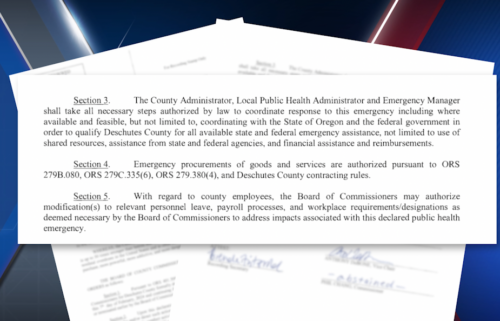Spence Mountain protected; Klamath County acquires public forest, tourism destination

KLAMATH FALLS, Ore. (KTVZ) – Rising dramatically above Upper Klamath Lake in Southern Oregon, Spence Mountain is home to oak and ponderosa pine woodlands, some of the rarest habitats in the state, and more than 47 miles of biking trails.
As of this month, it’s protected forever. That’s thanks to the Trust for Public Land, Klamath County, the Oregon Department of Forestry, and $4.6 million in federal funding from the U.S Forest Service Forest Legacy Program, administered through ODF.
"The Forest Legacy Program helps Oregon protect working forests, drinking water sources and habitat for fish and wildlife.” said Kelley Beamer, executive director of the Coalition of Oregon Land Trusts. “Spence Mountain adds a gem to our network of protected lands, creating expanded public access through hiking and biking trails. This project is a win for communities, the local economy, and conservation.”
Spence Mountain is now publicly owned by Klamath County. Its protection will have major economic and ecological benefits for the community. The 7,500-acre community forest will provide outdoor access for community members and recreationists. It will also preserve habitat for important species and supporting sustainable timber harvest.
The project received unanimous support from the Klamath County commissioners and U.S. Senators Ron Wyden and Jeff Merkley for its appropriations from the Forest Legacy Program.
“Oregon’s public lands and forests are iconic and vital in supporting the state’s economy, as well as addressing climate chaos,” said Merkley. “I am pleased to see the economic and environmental benefits this project will bring to the communities in Klamath County by supporting sustainable timber harvesting, providing public recreation such as mountain biking, and preserving habitats for endangered species.”
Spence Mountain is just one example of the impact of the Forest Legacy Program, a federal program funded through the Land and Water Conservation Fund. The Program is a partnership between the state of Oregon through the Oregon Department of Forestry, and the U.S. Forest Service. Their aim is to protect forestlands for drinking water, habitat for fish and wildlife, recreational opportunities, and management strategies that support local economies through sustainable timber harvest.
In Oregon, the program has helped preserve iconic landscapes like the East Moraine Community Forest in Wallowa County, Arch Cape Community Forest in Clatsop County and Gilchrist State Forest in northern Klamath County.
“This project couldn’t have achieved the success it did without the expertise and help from state and local partners," said Glenn Casamassa, regional forester for the U.S. Forest Service, Pacific Northwest Region. "With those from the Trust for Public Land, Klamath County, Oregon Department of Forestry and many others, we achieved a common goal of supporting and protecting Oregon’s public lands and the communities that depend on them.”
More federal funds coming for forest preservation
The Forest Legacy Program will get an additional $700 million in funding as part of the Inflation Reduction Act of 2022. With this increased investment, Oregon is poised to be a leader in forest protection in the country.
“We are at a crucial moment in time to invest in our forests, and the US Forest Legacy program is an important critical tool for increasing the scale and pace of forest protection and conservation in Oregon” said Cal Mukumoto, Oregon’s state forester. “I'm thrilled to see more money coming to this state to help us keep working forestlands intact.”
Demand for this program has grown over time, as land trusts build partnerships with local communities and state agencies to support the retention of healthy working forestland, and by expanding the impact of working forest conservation easements.
State Forester Mukumoto said The Trust for Public Land, Deschutes Land Trust, McKenzie River Trust, Pacific Forest Trust, and Columbia Land Trust all have potential projects that this program can support. “Some of these opportunities can be described as once-in-a-generation chances to protect private forestland from fragmentation and conversion,” he noted.
Funds to buy Spence Mountain also came from Oregon Parks and Recreation Department and National Fish and Wildlife Foundation.
# # #
About the Coalition for Oregon Land Trusts
The Coalition of Oregon Land Trusts (COLT) serves and strengthens the land trust community in Oregon. At COLT, we build connections and advance policies that help protect our natural world—our water, wildlife and open space—for all people, forever.
This work helps our coalition members—32 conservation organizations around the state—do what they do best: protect wildlife and wild places, defend working farms and forests, provide recreation and parks, drive climate solutions and science, champion clean water for all and engage communities to protect our natural world.
About the Oregon Department of Forestry
The Oregon Department of Forestry serves the people of Oregon by protecting, managing, and promoting stewardship of Oregon's forests to enhance environmental, economic, and community sustainability. Oregon’ largest fire department, ODF protects against wildfire some 16 million acres – more than half of Oregon’s forests. The agency protects privately owned forestland as well as some public lands, including state-owned forests. ODF scientists also provide assistance to landowners to identify forest pests, diseases and invasive species and how best to deal with them to keep their forests healthy. The agency’s rules help protect during harvesting and other forest work natural resources, such as water quality, soils and threatened and endangered species.
About the U.S. Forest Service – Pacific Northwest Region
The U.S. Forest Service, Pacific Northwest Region manages national forests and grasslands in Oregon and Washington, including 16 National Forests, a National Scenic Area, a National Grassland, and two National Volcanic Monuments.
The region’s State and Private Forestry branch works closely with industry, conservation organizations, Tribes, state and local governments, and communities in the Pacific Northwest to protect the health and resilience of the region’s forests and to ensure sustainable sources of timber, cattle forage, fish and wildlife habitat, clean water, and recreation on public and private lands – today and for future generations.



